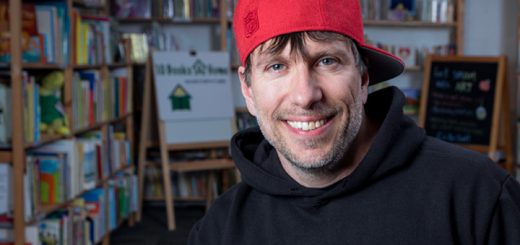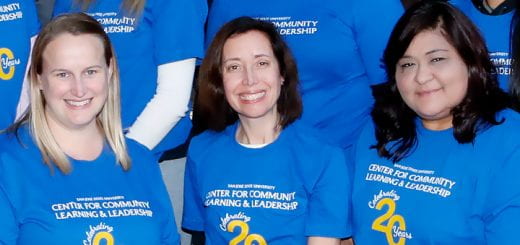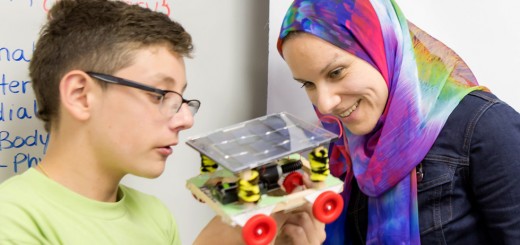Addressing Inequities in Early Childhood Education
When my daughter was six months old, I got a note from San Jose State’s Associated Students Child Development Center (ASCDC) saying it was time to schedule my first parent-teacher conference. I was stunned. What could they possibly tell me about my baby, who at that point didn’t even crawl? Her teacher handed me three pages of single-spaced typed observations, from how my daughter approached food, to the colors and sounds she reacted to in the classroom, and the gestures and noises she made while interacting with teachers and classmates. She also suggested activities to encourage further development. For the first time, it struck me that there was more to learn about early childhood education.
“Everybody has lived through childhood, so everyone believes that they are a de facto expert on it,” says Emily Slusser, chair of SJSU’s Department of Child and Adolescent Development department and faculty member in the Educational Leadership doctoral program. “There’s a science behind early childhood care and education. We are building empirical evidence in support of certain kinds of caregiving and educational instructional techniques—fields that are not often recognized.”
Slusser studies how cognitive processing works in small children. Her research involves one-on-one interactions with children and explores how they learn numbers. She also advises doctoral students who want to collaborate with lawmakers focused on early childhood education (ECE) policy.
In 2017, Slusser joined forces with Assistant Professor of Special Education Andrea Golloher and Associate Professor of Child and Adolescent Development Maria Fusaro to brainstorm ways to consolidate their research. Through the planned launch of the Early Childhood Institute, they hope to unite SJSU faculty members and students with parents, ECE practitioners, caregivers, advocacy groups and legislators to address inequities in early childhood education, ranging from the devaluing of infancy and toddler care to the need for integrated special education training for teachers across the board. This is great news for young children, caregivers, ECE advocates and parents. This means when I have questions about my daughter’s ability to learn, communicate or behave in certain situations, I can turn to experts with access to real-world data for help.
“We noticed there wasn’t a lot of communication between our fields,” says Slusser. “Early childhood and special education often operate within the K-12 public school system, whereas early childhood educators are bound by different standards. Some have credentials. Others have permits. Our idea is if these fields communicate and collaborate with one another, all children will benefit.”
Increasing Access and Awareness
According to a 2017 Learning Policy Institute report, there’s no standardized statewide ECE system. Parents must navigate school readiness programs, including California State Preschool, Head Start and Early Head Start, transitional kindergarten and subsidized programs—though program eligibility depends on socioeconomics and geographic region. This means that families displaying the greatest economic need might not be aware or might not understand how to take full advantage of their ECE options.
“We see a major disconnect between the importance of early childhood experiences,” says Golloher, who previously worked as a preschool special education teacher and in-home therapist for children with autism and other developmental delays. Her research examines the impact of literacy curricula on students with low language abilities. She observes young learners as well as the subtle differences in teaching methods that affect students of all abilities. “Our work speaks to the value of high-quality early childhood experiences. The systems that are available to support young children are disjointed. How can we bring our knowledge to those systems to try and support educators?”
Golloher says this inequity means that incoming kindergartners have no guaranteed equal playing field. Some kids may arrive at school with strong literacy skills, such as being able to recognize their letters, write their names, answer questions about a story and possibly read, while others are arriving with weaker language and literacy abilities. ECE research establishes a baseline of the skills and competencies infants and children need to best prepare them for K-12 education. For young children, supportive adult-child interactions and caring relationships set the foundation for healthy development, says Fusaro, who brings expertise and research experience in early communication skills and the preparation of undergraduates for careers in infant/toddler care and education.
“Sometimes, preschoolers and young children get overlooked and, even more so, babies and toddlers,” says Fusaro. “It’s critical to make sure there is a specific focus on providing positive learning experiences from birth to age five. There’s a shortage of childcare availability, particularly for birth to age three. It’s not just about access. It’s about access to high-quality programming.”
Fusaro emphasizes that “high-quality programming” can be achieved through in-home settings, with nannies and in subsidized preschools, as well as at home with family. As a new parent, I sometimes struggled to find things to do with my daughter. I was amazed when my daughter’s teacher introduced finger painting to her class when her students were only seven months old. I had no idea what was developmentally appropriate and what would encourage her to keep learning. It made me wonder, how can caregivers and parents access educational resources and receive the latest research and training to benefit young children?
A Hub for ECE Research
The narrative around early childhood education, as well as the resources allotted to it, are changing in California. In 2019, Governor Gavin Newsom’s comprehensive state budget established funding for universal preschool for all income-eligible four-year-old children in California, phased over a three-year period. The budget also included $500 million one-time general funds to build childcare infrastructure, including in the education of the childcare workforce. In Santa Clara County alone, three million dollars was allocated to create the inaugural Santa Clara County Children’s Budget, which will broaden the scope of support for childcare facilities countywide.
At SJSU, Slusser, Fusaro and Golloher have launched the Early Childhood Institute, a research hub that will provide resources to students, educators, administrators, policymakers, parents and members of the community. While SJSU has long been known as the provider of teachers to the workforce, now it will be uniting teachers with the researchers whose expertise reflects the latest trends and findings in early childhood education.
My daughter is now three years old. She rattles off songs and stories, rides tricycles in the yard, recites the alphabet and is quick to correct me, saying “Mom, I told you …” She is a vibrant, chatty, smart kid, and I’m not just saying that because I’m her mom. I, for one, am grateful for the skills and tips from teachers, administrators and professors like Slusser, Fusaro and Golloher.
“Our goal is to make ECE research accessible,” says Slusser. “We are really in a position to make substantive change in the local community. We are the trainers of the early childhood workforce. It’s a unique opportunity for everyone.”






